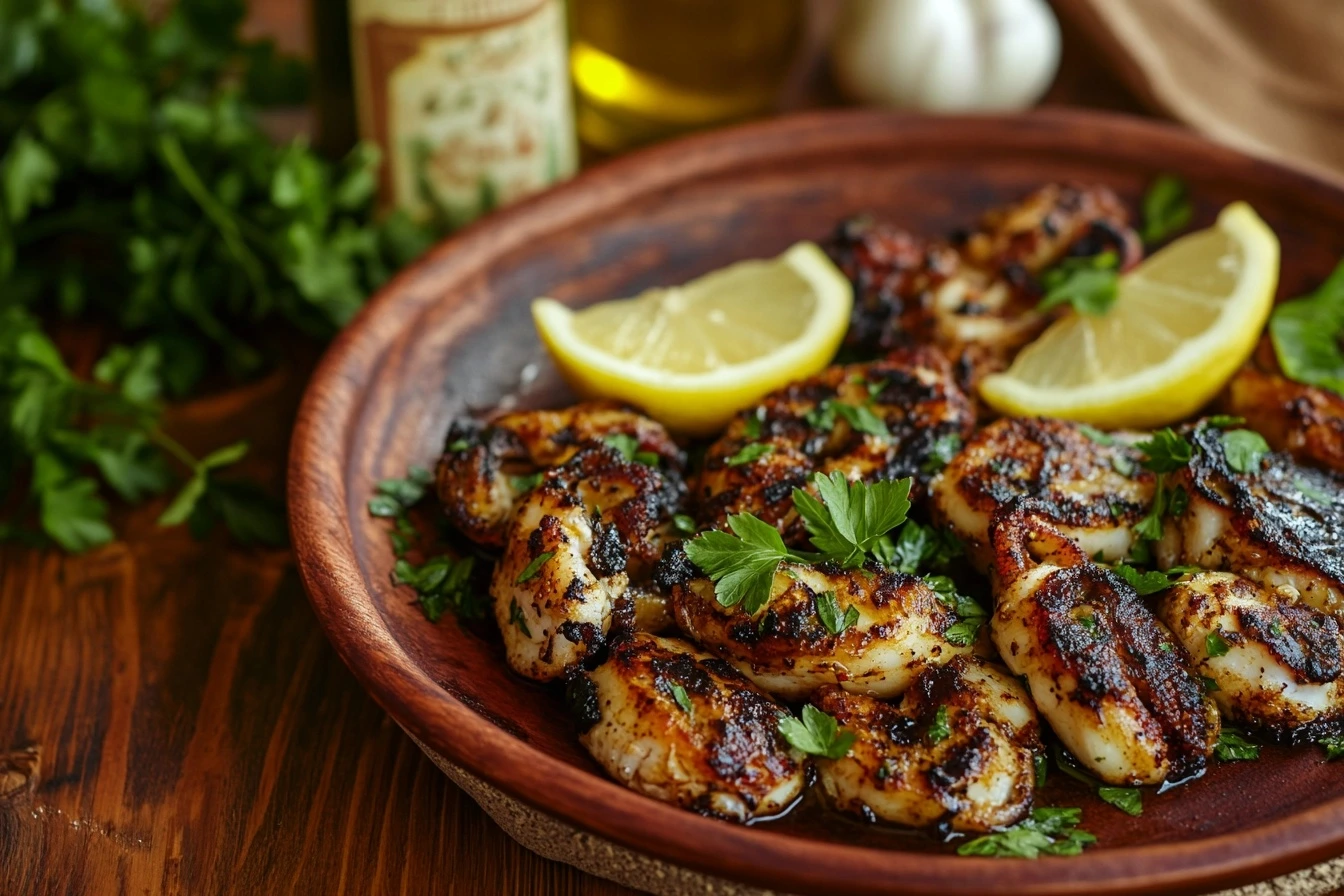Introduction
Baby octopus is a versatile seafood ingredient that can elevate your lunch menu with its delicate flavor and tender texture. Whether you’re a home cook looking to impress your family, a busy parent aiming for quick yet healthy meals, or a food enthusiast exploring new culinary adventures, baby octopus recipes offer something for everyone. This seafood delicacy is widely popular in Mediterranean and Asian cuisines, where its adaptability allows it to shine in a variety of dishes.
Here at Sista Recipes, we’re passionate about bringing you simple yet extraordinary recipes that inspire joy in the kitchen. Cooking with baby octopus may seem daunting, but once you learn the basics, you’ll see how effortlessly it can fit into your routine. From marinated baby octopus bursting with Mediterranean flavors to crispy, golden-fried bites perfect for appetizers, there’s a recipe to suit every occasion.
Looking for complementary dishes? Pair your baby octopus with our Tuck Fish Passover Potato Pie for a hearty, flavorful meal, or explore the robust flavors of our Lebanese Lamb with Lentils and Spinach to complete a Mediterranean-inspired feast.
As you dive into these recipes, you’ll discover tips for preparation, flavor pairing ideas, and foolproof methods to achieve the perfect texture every time. So, let’s embark on a flavorful journey to uncover the secrets of cooking!
Print
Baby Octopus Recipes: From Marinated Perfection to Crispy Bites
- Total Time: 45 minutes
- Yield: 4 servings 1x
Description
A versatile and flavorful collection of baby octopus recipes—marinated, grilled, and crispy—that bring Mediterranean and Asian culinary traditions to your kitchen.
Ingredients
- 1 lb baby octopus, cleaned
- 3 garlic cloves, finely minced
- Juice of 2 lemons
- 3 tbsp extra-virgin olive oil
- 1 tsp dried oregano
- ½ tsp smoked paprika
- Salt and pepper to taste
- 1 tsp garlic powder (for grilled version)
- ½ cup all-purpose flour (for crispy version)
- ¼ cup cornstarch (for crispy version)
- Oil for frying
- Lemon wedges for garnish
Instructions
- Rinse and clean the baby octopus under cold water. Remove the beak and trim any tough parts if needed.
- Boil the octopus with aromatics (lemon slices, garlic, bay leaf) for 20–30 minutes to tenderize.
- For the marinated version: whisk olive oil, lemon juice, garlic, oregano, paprika, salt and pepper. Marinate octopus for at least 2 hours or overnight. Sear on a grill pan for 2–3 minutes per side until caramelized.
- For the grilled version: toss boiled octopus with olive oil, smoked paprika, garlic powder, salt and pepper. Grill on medium-high for 2–3 minutes per side until slightly crispy.
- For crispy bites: pat dry boiled octopus, then coat with a mixture of flour, cornstarch, garlic powder, paprika, and salt. Fry at 350°F (175°C) for 3–4 minutes until golden. Drain on paper towels.
Notes
Pair baby octopus with Greek salad, tzatziki, or roasted potatoes for a full meal. For Asian-inspired flair, try marinades with soy sauce, sesame oil, and ginger. Don’t skip tenderizing for the best texture.
- Prep Time: 15 minutes
- Cook Time: 30 minutes
- Category: Main Dish
- Method: Boiled, Grilled, Fried
- Cuisine: Mediterranean, Asian
Nutrition
- Serving Size: 1 serving
- Calories: 320
- Sugar: 1g
- Sodium: 480mg
- Fat: 15g
- Saturated Fat: 2g
- Unsaturated Fat: 10g
- Trans Fat: 0g
- Carbohydrates: 10g
- Fiber: 1g
- Protein: 35g
- Cholesterol: 120mg
Keywords: baby octopus, seafood recipes, grilled octopus, fried octopus, marinated octopus
Table of Contents
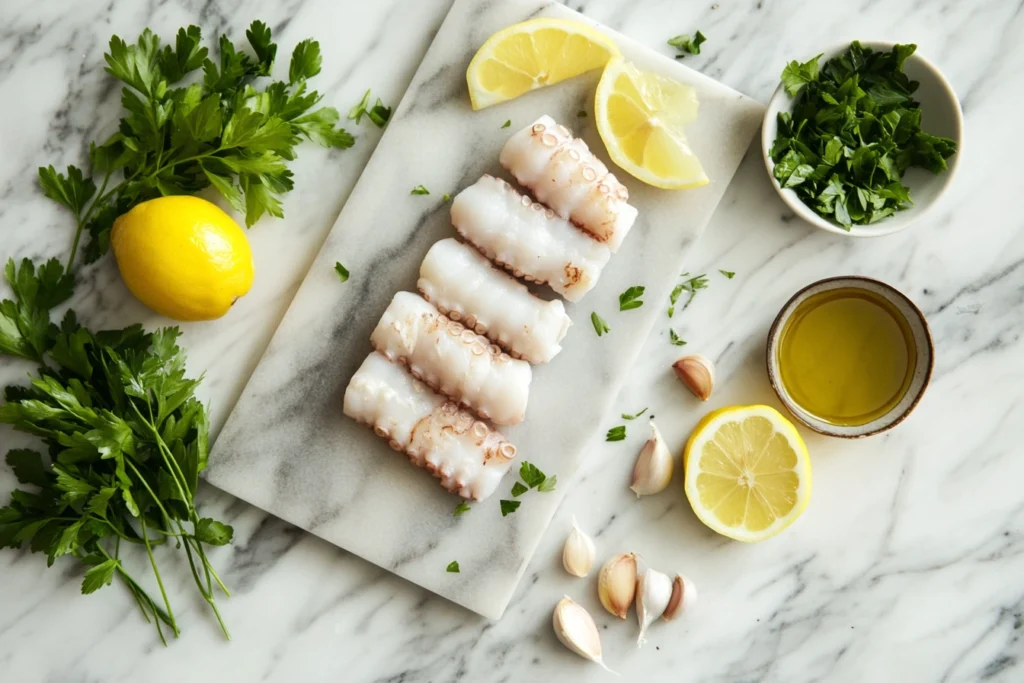
What is Baby Octopus?
Before diving into the recipes, it’s important to understand what makes this seafood delicacy so special. Unlike its larger counterparts, the smaller octopus is prized for its petite size, which makes it naturally tender and quicker to prepare. Measuring just a few inches long, it’s ideal for both simple meals and intricate dishes that require precision.
Its flavor is mildly sweet with a touch of oceanic freshness, making it an excellent base for marinades and seasonings. When cooked properly, the texture is soft and succulent, allowing it to absorb bold flavors while maintaining its delicate profile. This ingredient is beloved in global cuisines, particularly in Mediterranean and Asian dishes. For instance, in Greece, grilled octopus is a favorite at traditional tavernas, often paired with sides like Greek Yogurt Garlic Breadsticks for a complete meal. Meanwhile, in Japan, Chuka Iidako is a popular cold appetizer featuring a sweet and savory glaze, frequently enjoyed alongside sushi.
Thanks to its versatility, this seafood is a perfect addition to your lunch repertoire, offering endless opportunities to explore new flavors.
The Art
Cooking baby octopus begins with proper preparation. While it might seem like a complicated process, the steps are straightforward and ensure you achieve tender, flavorful results.
Cleaning and Prepping
Start by rinsing your baby octopus under cold water to remove any grit or sand. If it hasn’t been pre-cleaned, you’ll need to remove the beak, which is located at the base where the tentacles meet. Simply push it out with your fingers or a small knife. Next, trim any excess membranes or tough parts for a smoother texture.
For those new to cooking octopus, tenderizing is an essential step to avoid chewy results. A common method is to boil the octopus for 20–30 minutes with aromatics like bay leaves, lemon slices, and garlic. This not only softens the meat but also infuses it with subtle flavors. If you’re short on time, marinating the octopus in acidic ingredients like lemon juice or vinegar can also help break down tougher fibers, ensuring a melt-in-your-mouth texture.
Cooking Methods Overview
The beauty of baby octopus lies in its adaptability to various cooking techniques. Grilling adds a smoky char that enhances its natural sweetness, while sautéing is perfect for quick, flavorful dishes. Braising allows the octopus to soak up rich sauces, making it a comforting option for heartier meals. For a crowd-pleasing appetizer, frying transforms baby octopus into crispy, golden bites that are impossible to resist. Each method brings out unique qualities, giving you endless possibilities in the kitchen.
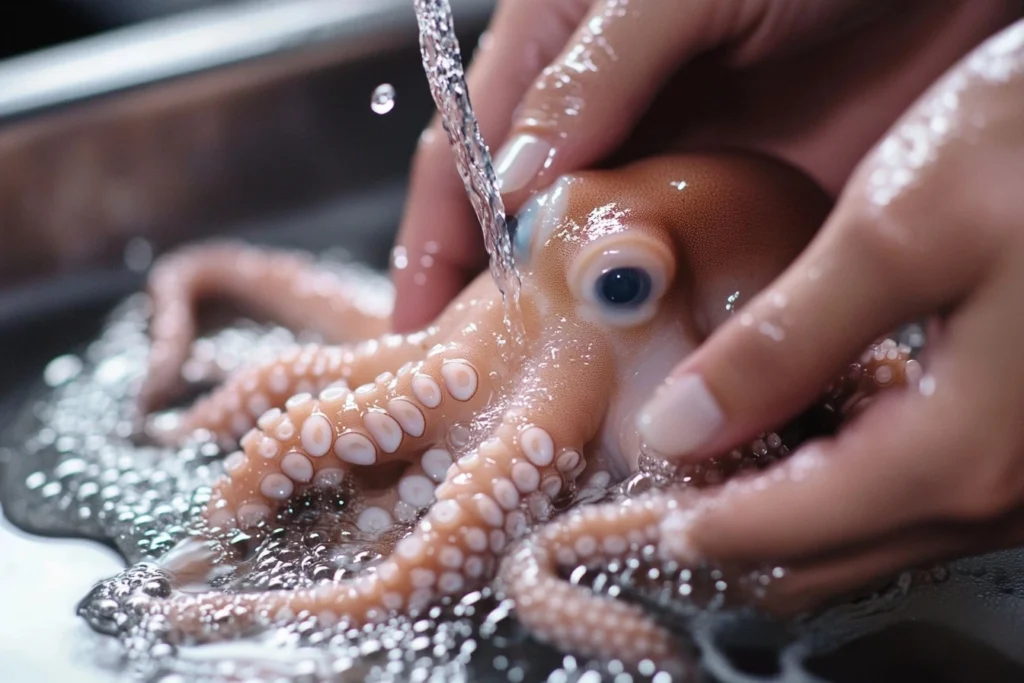
Recipe 1: Marinated
A Mediterranean-inspired marinade is the perfect way to bring out the best in baby octopus. This recipe highlights the simple yet bold flavors of garlic, olive oil, and lemon.
Ingredients Needed
- 1 lb baby octopus, cleaned
- 3 garlic cloves, finely minced
- Juice of 2 lemons
- 3 tbsp extra-virgin olive oil
- 1 tsp dried oregano
- ½ tsp smoked paprika
- Salt and pepper to taste
For variation, you can also try an Asian-inspired marinade using soy sauce, sesame oil, ginger, and a touch of honey for sweetness.
Step-by-Step Instructions
- Prepare the marinade: In a bowl, mix olive oil, lemon juice, minced garlic, oregano, smoked paprika, salt, and pepper. Whisk until well combined.
- Marinate the octopus: Add the cleaned baby octopus to the bowl, ensuring each piece is well-coated. Cover and refrigerate for at least 2 hours or overnight for deeper flavor penetration.
- Cook the octopus: Begin by boiling the marinated octopus for 15–20 minutes to tenderize it. Drain and let it cool slightly.
- Finish with searing: Heat a grill pan or skillet over medium-high heat. Add the octopus and sear for 2–3 minutes per side until caramelized and slightly crispy.
Serving Suggestions
This marinated baby octopus pairs beautifully with a Greek salad or crusty bread. It also works well as part of a seafood platter, which you can explore more about in our guide on Perfect sides for seafood platters.
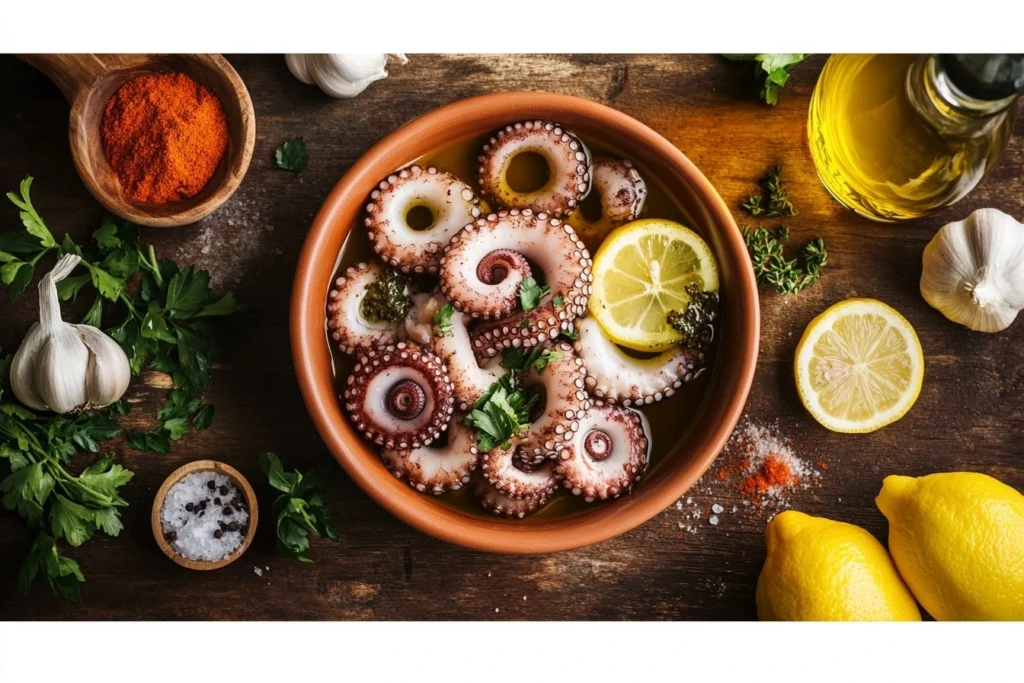
Recipe 2: Grilled
Grilling is one of the most popular ways to prepare baby octopus, as it brings out a smoky, slightly charred flavor that’s irresistible.
Ingredients Needed
- 1 lb baby octopus, boiled and tenderized
- 2 tbsp olive oil
- 1 tsp smoked paprika
- 1 tsp garlic powder
- Lemon wedges, for garnish
Step-by-Step Instructions
- Preheat your grill to medium-high heat.
- Toss the boiled octopus in olive oil and season with smoked paprika, garlic powder, salt, and pepper.
- Place the octopus on the grill, turning occasionally to ensure even charring. Grill for 2–3 minutes per side or until slightly crispy.
- Remove from the grill and garnish with lemon wedges for a fresh, zesty finish.
Serving Suggestions
Serve this dish with roasted potatoes or a side of tzatziki for a complete Mediterranean-inspired meal. For more ideas, check out our guide on Mediterranean-inspired dishes to try.
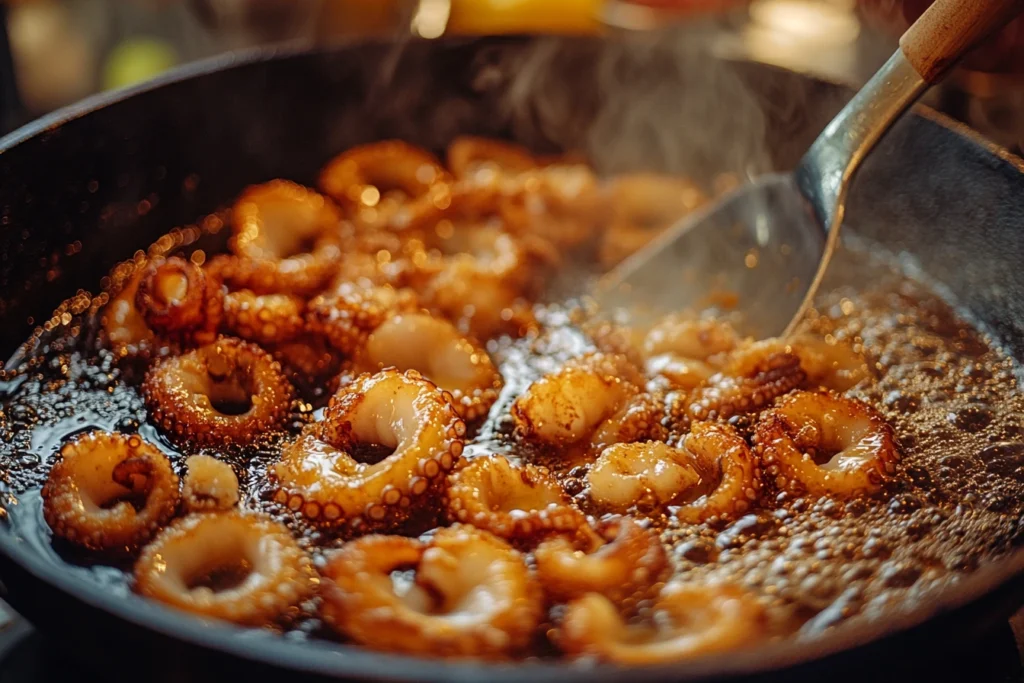
Recipe 3: Crispy Baby Octopus Bites
For an indulgent appetizer, crispy fried baby octopus is a must-try. The contrast between the crunchy exterior and tender interior creates a dish that’s perfect for sharing.
Ingredients Needed
- 1 lb baby octopus, boiled
- ½ cup all-purpose flour
- ¼ cup cornstarch
- 1 tsp garlic powder
- 1 tsp smoked paprika
- Oil for frying
Step-by-Step Instructions
- Start by patting the boiled octopus dry with a paper towel to ensure the batter adheres well.
- In a bowl, combine flour, cornstarch, garlic powder, smoked paprika, and a pinch of salt.
- Coat each piece of octopus in the dry mixture, shaking off excess.
- Heat oil in a deep pan to 350°F (175°C). Fry the octopus in small batches for 3–4 minutes or until golden brown.
- Drain on paper towels and season with a sprinkle of salt.
Serving Suggestions
Pair these crispy bites with dipping sauces like spicy aioli or citrus mayo. For more appetizer ideas, explore our guide on Appetizers and starters to complement seafood.
Health Benefits
Baby octopus isn’t just delicious—it’s also packed with nutrients. Rich in protein and omega-3 fatty acids, it supports muscle health and boosts brain function. Its low calorie and fat content make it a smart choice for diet-conscious individuals.
Additionally, baby octopus provides essential vitamins and minerals, including vitamin B12, iron, and selenium, which contribute to energy production, immune function, and overall well-being. Including baby octopus in your meals is a simple way to enjoy flavorful dishes without compromising on nutrition.
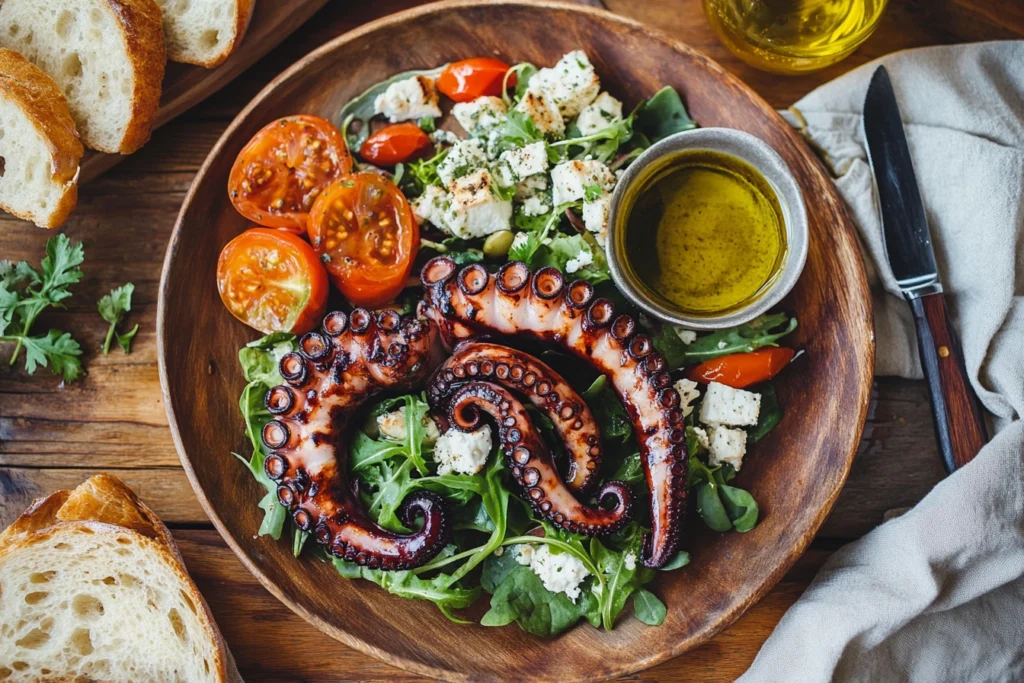
Cultural Influences and Regional Variations
This unique seafood is celebrated in various cuisines, each showcasing its distinct qualities through local flavors and techniques. In Mediterranean countries, particularly Greece and Italy, it is often grilled or braised with olive oil, lemon, and fresh herbs. These simple ingredients highlight the natural sweetness of the dish while adding a touch of zest.
In Japan, Chuka Iidako is a popular cold appetizer featuring small octopus marinated in a sweet and savory glaze, often served alongside sushi. Meanwhile, in other parts of Asia, octopus is stir-fried or braised with bold flavors like chili, garlic, soy sauce, and sesame oil, creating dishes that are both aromatic and delicious.
Thanks to its versatility, this seafood delicacy easily adapts to different culinary traditions, making it a favorite for home cooks and professional chefs alike. If you’re eager to try out Asian-inspired recipes, don’t miss our guide on Asian-style seafood delicacies for more creative ideas.
Tips and Tricks
Cooking may require some practice, but these tips will help you achieve perfect results every time:
- Don’t skip tenderizing: Boiling the octopus before grilling, frying, or sautéing ensures a soft texture without becoming chewy.
- Marinate for flavor: A well-prepared marinade not only enhances taste but also helps to tenderize the octopus further.
- Avoid overcooking: Baby octopus cooks quickly, so keep an eye on it to prevent it from becoming rubbery.
- Dry thoroughly before frying: If you’re frying baby octopus, pat it dry to ensure a crispy coating.
With these tips in mind, you’ll find it easier to incorporate baby octopus into your cooking repertoire, whether you’re preparing a simple lunch or hosting a special occasion.
FAQs
1. What do you call a baby octopus?
A baby octopus is often referred to simply as “baby octopus.” It’s a smaller version of the common octopus species, not necessarily a juvenile. In some cuisines, it may have specific names, such as Chuka Iidako in Japanese dishes.
2. Is calamari a baby octopus?
No, calamari is not baby octopus. Calamari refers to squid, a completely different species of marine animal. While both are popular in seafood dishes and have similar textures, they are distinct in flavor and preparation methods.
3. What is baby octopus food called?
The culinary name for dishes made with baby octopus varies by cuisine. In Mediterranean cooking, it’s often grilled or braised and served as “grilled octopus” or “octopus salad.” In Japanese cuisine, sweet marinated baby octopus is called Chuka Iidako, and in Asian recipes, it may be simply referred to as stir-fried or braised baby octopus.
4. Can you cook baby octopus from frozen?
Yes, you can cook baby octopus from frozen. However, it’s best to thaw it first for even cooking. To thaw, place the frozen octopus in the refrigerator overnight or submerge it in cold water for quicker results. Once thawed, proceed with cleaning, marinating, or tenderizing as needed.
Conclusion
Baby octopus is more than just a seafood ingredient—it’s an opportunity to create memorable meals that bring people together. From marinated and grilled recipes to crispy fried bites, this versatile delicacy offers endless possibilities for home cooks of all skill levels.
By following the recipes and tips shared in this guide, you’ll not only master the art of cooking baby octopus but also enjoy the satisfaction of preparing dishes that are both delicious and nutritious. Whether you’re hosting a family dinner or exploring new flavors on your culinary journey, baby octopus is sure to impress and delight. So, roll up your sleeves, grab your favorite seasonings, and let’s make something extraordinary with baby octopus today!

